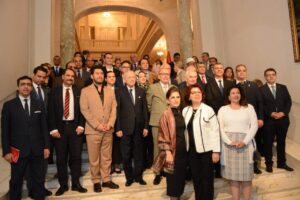
Ashraf AboArafe
All thanks and appreciation to the Turkish Embassy and the work team led by the veteran diplomat, Ambassador Salih Mutlu Shen, for the birth of the idea and turning back the wheel of time to enjoy a past from which we can draw the present and shine the future. In silence and reverence, the international politician, diplomat, scientist, and writer, Professor Dr. Ekmel Ihsanoglu, sailed with the attendance – politicians… diplomats… academics… media figures – from the great Nile of Egypt, the starting point, to the Phosphorus Sea, the arrival point, or vice versa, to narrate some of the pages of his book, “The Turks in Egypt.” “From 1516 to 1914, it was full of politics, literature, and science through its pioneers, Mustafa Kemal Ataturk, Princess Qadriya Hussein Kamel, and Muhammad Akif Ersoy… and even the narrator himself, the son of the writer Ihsanoglu, and the Turkish language teacher in Egyptian universities, Mr. Ekmel Ihsanoglu, as one of the secretions of these people, to stand as a witness to the era.
And the harmony of the Nile and the Bosporus together, although this is sweet and that is salt, nevertheless they flow through the arteries of the Egyptians and the Turks due to alternation and good rhythm, so that the bonds of love and brotherhood between the two peoples are evident to this day and since the creation, and not only as it is said since the Ottoman conquest, but they reached the peak of development over the course of about four centuries and the story of the Empire of the Seven Provinces. On which the sun never set.
The book, published by Prof. Dr. Ihsan Oglu who completed his work in 2006 under the title The Turks in Egypt and Their Cultural Heritage, with three main sections: The Turks in Egypt and Their Culture, Publishing Turkish Books in Egypt, and A Bibliography of Turkish Culture Printed in Egypt.
The professor was born in Egypt and lived in Egypt until he finished his university education. Ihsanoglu began his first work in the early 1960s and was able to complete his book as a result of his research in different countries over 40 years.
Ihsanoglu’s book attracts attention by providing a first-hand source for those conducting research on Turkish history, literature, language, music, books, printing, journalism, military service, culture, politics, and the history of translation in the nineteenth and early twentieth centuries.
One of the striking topics in the first part of the book is primarily the section of female poets and writers who grew up in the palace and its surroundings. Thus, it has drawn the attention of literary historians and researchers to women poets and writers who lived in Egypt, which is being discussed in detail for the first time.
 The second part is to draw the historical framework of the Turkish position in the field of education and military service, which is the key to Muhammad Ali Pasha’s modernist attempts, and explain its beginning, development and end, Turkish textbooks taught in the Egyptian language schools, Turkish education in Sudan, Turkish military literature, the Egyptian translation movement in Turkey, the status of the Turkish language and its importance in this movement, and an evaluation of translations from Eastern and Western languages.
The second part is to draw the historical framework of the Turkish position in the field of education and military service, which is the key to Muhammad Ali Pasha’s modernist attempts, and explain its beginning, development and end, Turkish textbooks taught in the Egyptian language schools, Turkish education in Sudan, Turkish military literature, the Egyptian translation movement in Turkey, the status of the Turkish language and its importance in this movement, and an evaluation of translations from Eastern and Western languages.
The third important title is the general evaluation of Turkish books printed in Egypt, firstly, the Bulaq Printing House and the Turkish book printing of the Bulaq Printing House in the period of Muhammad Ali Pasha and in the period immediately following Sultan II. It includes books published in Egypt during the era of Abdul Hamid (1876-1909), publications by the Young Turks and other political opponents, and an overview of books published in the twentieth century.
The second part of the book, titled Turkish Book Printing in Egypt, deals with the subject that forms the starting point of this book, namely the Bulaq Printing House (established by order of Mehmed Ali Pasha), which can be seen as the second cornerstone of the as-yet-unwritten history of Turkish printing. Mutivrika Printing House (1729. 1822) and the Turkish book printing that began with it.
The inclusion of titles in Ihsanoglu’s sources provides great convenience to researchers. In this study, an almost complete bibliographic study was produced by reviewing and comparing library catalogs and bibliographies related to books, as well as reviewing the majority of books.
Such a study was meticulously conducted by Prof. I have paved the way for İhsanoglu’s assessments in the first two chapters of his book to be accurate, complete, and reliable.




